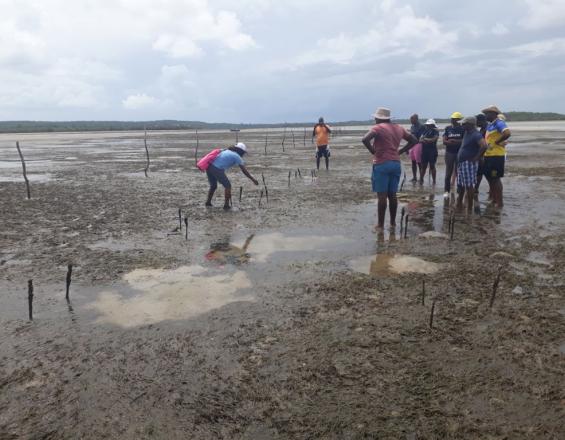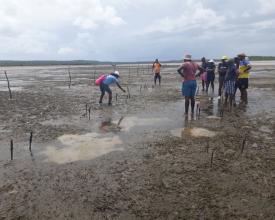
Seagrass meadows restoration in Mozambique

Seagrass meadows provide many ecosystem services, from fish juveniles nursery, to feeding ground for dugongs and sea turtles, coastal erosion mitigation and carbon sink.
Seagrass meadows are subjects to degradation like many other natural ecosystems. Our research team tested several seagrass restoration methodologies. Some of them have been successful. We involved local communities in the restoration work, to raise awareness on the importance of seagrass, create ownership and reflect about the threats to seagrasses, as well as on the risks of reducing their importance for their livelihoods that depend on wealthy seagrass meadows.
From 2017 to 2020, we conducted trainings on restoration methods, revisited the causes of degradation and assessed the restoration piloted in three different sites. Seagrass beds’ main drivers of degradation are cyclones, sand accretion, trampling and sedimentation from flooding, as well as seagrass uproot for clams collection.
Context
Challenges addressed
In Mozambique, like in the wider Western Indian Ocean region, specific data on this ecosystem is still quite scarce.
Seagrasses meadows are degraded by recurrent cyclones and related flooding that prompted sedimentation, exploitation of clams by means of uproot and death of seagrass, and trampling.
Location
Process
Summary of the process
The successful restoration methodology was key for restoring degraded seagrass beds, but it was only the technical component. The social scientists have a major role in this work, as they help with engaging the communities, to eventually foster ownership, reflected in the formation of the A-TANYI association. By creating their own entity, the community members can interact with other stakeholders. They take care of the seagrass meadows, apply best practices and raise awareness. It shows a cultural change in the society.
Building Blocks
Successful seagrass restoration methodology
The rod method was the main restoration method that we implemented. It was selected given its relatively higher survival rate (around 2/3) of the restored modules of one rod of seagrasses.
The rod method is a manual sediment free method for seagrass restoration, which consists in the use of a wire stick or rod, where seagrass is tied and attached to the ground. The wire is bent and both ends are anchored in the soil, forming a so called rod. Seagrass modules (2-3 shoots united with the same rhizome) are attached to the rod. These rod structures are fully degradable after just over a year.
In Inhambane, we tested a palm leave nerve as a rod, as described as tségua method, having the disadvantage to be a highly time consuming restoration method.
Enabling factors
- Identification of wealthy donor material: A donor seagrass is an area/field of seagrass qualified to offer vegetative material for restoration. The same donor is capable to replenish itself naturally. We have been doing regular observation of these; having standard shoot density, number of leaves per shoot (=seagrass stem).
- Being manual method, with a small cost and implemented in shallow areas, with no need regular swimming. Diving was not required
- Trained students
- Presence of communities
- Having a dedicated NGO as a project partner
- Some funding
Lesson learned
The success of the ongoing restoration is due to testing different restoration methodologies, engage local communities at the earlier stage of seagrass restoration and making good choice of areas, that are not heavily impacted by gleaners or other factors.
Social scientists to work with local communities
The seagrass restoration project had, at its onset, a social scientist who helped with collecting data related to perception of seagrass, with steering the discussions with NGOs, and with leading the awareness raising campaigns and formalization of initial thoughts about the need for managing the seagrass meadows.
Enabling factors
- Communication skills, including speaking local African language
- Awareness raising
- Ownership by the communities created through the formation of community-based organisations to engage in the different seagrass restoration activities
Lesson learned
- It is good to involve social scientists at the beginning of a seagrass restoration to work on socio-anthropological related issues
- Social scientists build the bridge between ecologists and communities given their role in communication and documentation of socio-ecological issues
- Their complementary actions enable to faster reach the goal of engaging communities in seagrass restoration
Formation of the A-TANYI seagrass association
The association A-TANYI was formed after several meetings were held with the communities, to raise the awareness on the importance of seagrass. Association members, including women, engage in protecting and managing the restored seagrass meadows.
Enabling factors
- Meetings co-lead by the University Eduardo Mondlane and partner NGOs, to brainstorm with communities on the importance of seagrass and the threats to this ecosystem
- The principle of voluntarism is an important prerequisite to be part of an association
- The association charter was elaborated in a consultative manner, and its representatives were elected by the community members.
Lesson learned
- The association created in fact a reference community group, that has deep local knowledge on seagrass and their related other resources
- Discussions that drive thorough reflections on the issues related to seagrass but also their uniqueness, unfold the need to protect and manage this ecosystem, as well as becoming a member of the association
- Several meetings were needed, to introduce and document strengths, weaknesses and opportunities to start a seagrass management agenda.
Impacts
- Nearly 1.5 ha mostly restored of the Cymodocea serrulata seagrass meadows (mostly in Inhaca but includes also Inhambane). Other seagrass species (Halodule uninervis and Thalassia hemprichii) were restored.
- Seagrass restoration methodologies tested and documented with three methodologies: sediment method (sod), sediment free methods (rod - as explained in Building Block 1) and finger method. The sod method corresponds to clod of seagrasses that are detached from a donor bed by means of a shovel or a pvc/polythene tube
- Data collected on species and environmental parameters
- 3 post-graduate students trained
- Several communities were involved in the restoration work, which raised their awareness on the importance of seagrass.
Beneficiaries
- Local communities from both Maputo Bay and Inhambane Bay
- Fisheries Community Council
- A-TANYi - Community Conservation Association of Inhaca Island
- NGOs (Ocean Revolution Mozambique, KUWUKA JDA-Environmental advocacy)
- Students
- Government / munincipality
Sustainable Development Goals
Story
All of a sudden, I see squares in google maps. I wonder, but these are the result of seagrass restoration that have been going on since 2019 at Inhaca Island, east of Maputo Bay. Students were at the forefront of this initiative but once we were sure about the most successful restoration techniques, we contacted the community members, mostly women. The latter with the support of NGO KUWUKA and a social-scientist at UEM started engaging communities in deep refletions, sensitization and capacity assessment to engage in a voluntary work that would culminate being the best advocates of the seagrass restoration at Inhaca. People wonder about this initiative that is emerging. A-TANYI, the community association was created. Fotos and videos out of this place shows thriving seagrass meadows, with an already increasing fauna!
